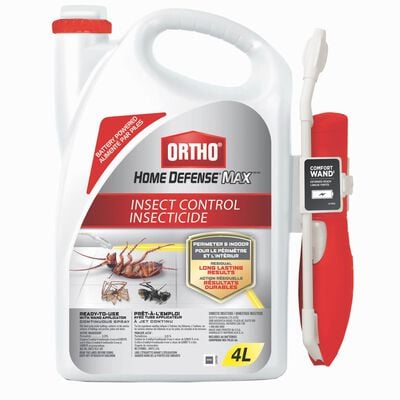
How to Kill & Control Cockroaches
Cleanliness is an important step to fighting this common pest. But it's only the first step to controlling them.
Cockroaches may be the grossest pest to ever scurry across a kitchen counter. These disease-carrying scavengers crawl up and into your cabinets, chew through packaging, and eat your food. Along the way, they leave droppings that contaminate everything in its path.
In short, they're the worst.
Over millions of years, cockroaches have evolved as some of the hardiest survivors around. They can go months without food, and they can eat just about anything, even if it's disgusting. These little scavengers feast on everything from food crumbs to beer, soda, book bindings, feces, wallpaper glue, decaying plant matter, and much more. It may be easier to list what cockroaches won't eat.
Higher up the food chain are several different predators that eat cockroaches, such as toads, frogs, lizards, hedgehogs, birds, and rats. Smaller creatures, like praying mantises, large beetles, certain wasps, and brown recluse spiders also prey on them.
Cockroaches are notorious for spreading diseases such as salmonella, staphylococcus infections, E. coli, typhoid fever, and gastroenteritis. They also trigger allergies and asthma attacks.
As soon as you see one in your home, it's time to spring into action because cockroaches rarely travel alone. This article will show you how to identify and control cockroaches, how to prevent them from returning, and how to clean and disinfect your home after an infestation.
How to Identify Cockroaches
Of the thousands of cockroach species that exist, the German cockroach is the one most commonly found in Canadian homes, even as far north as Nunavut. They are 12-17 mm long with tan to light brown bodies. Females produce up to eight egg capsules in their lifetime, and each capsule contains about 40 eggs.
Cockroaches are nocturnal creatures that hide during the day, but they leave droppings everywhere they go. Many people notice the droppings as the first sign of an infestation.
Like so many pests, cockroaches live in warm, humid, and dark environments with plenty of food and water nearby. If you think you have a cockroach infestation, look for them here:
- In the basement, kitchen, or bathroom
- Near a plumbing leak, septic tank, or anywhere with standing water
- Underneath the kitchen or bathroom sink
- In attics and crawl spaces
- Under mulch, decaying leaves, or roof shingles
- Inside bushes and tree holes
How to Get Rid of Cockroaches
Foggers and bombs are not good solutions for getting rid of cockroaches. They usually cause the bugs to scatter and find new hiding places, making a bad infestation even worse. Try these roach killer methods instead:
- Mix equal parts of sugar and baking soda and put the mixture into shallow bowls. Set the bowls where you suspect the cockroaches hide. The cockroaches will eat the sugar, and the baking soda will cause their stomachs to expand, which kills them.
- Catnip is a kid-friendly and pet-friendly way to get rid of cockroaches because they hate the smell. Simmer a pan of water, and add catnip. After the catnip tea cools, fill a spray bottle and spray the solution on baseboards, in basement or attic corners, and any place that houses cockroaches.
- Ortho® Home Defense Max® Perimeter & Indoor Insect Control
- Ortho® Ant B Gon
- Ortho® Ant B Gon
How To Prevent Cockroaches
After taking care of an infestation, keep cockroaches from coming back by creating an unfriendly environment for pests. Here's how:
- Lower the humidity in your home to 50% in the summer with an air conditioner or dehumidifier.
- Cover air vents and floor drains with mesh to prevent roaches from crawling inside.
- Seal cracks and pipe openings Repair torn screens, leaky pipes, and plumbing fixtures.
- Create a bug barrier around your home with
- Store potato chips, cereal, pet food, treats, and other bags of food in containers with tight-fitting lids.
- Take garbage and recyclables out of the house daily.
- Sweep underneath the refrigerator and stove regularly. If possible, unplug and move these appliances so you can thoroughly clean behind them on occasion.
How to Clean Up Dead Cockroaches
Cockroaches can harm your health even after they're dead. For this step, wear gloves and a protective mask to avoid touching or inhaling contaminated materials.
Sweep the dead cockroaches up with a vacuum or broom. Since they are so good at hiding, you'll want to move boxes and furniture and sweep underneath and behind the refrigerator, stove, and other large appliances. Use vacuum attachments to suck cockroach bodies out of cracks and crevices. When you're finished, dispose of everything in a garbage bin outside.
Next, thoroughly clean every room that you saw a cockroach crawl through. In the kitchen, use hot, soapy water to wash all dishes, pans, mixing bowls, and flatware. Wipe down countertops and other surfaces with a bleach and hot water solution or your favorite germ-killer.
To clean the bathroom, throw the floor mat and hand towels into the washing machine. Disinfect the soap dish, sink, toilet, and tub, and mop the floor.
If you have kids, steam clean or wash their toys, bedding, and anything a cockroach could have crawled on. Run pet bowls and dog toys through the dishwasher or wash them in hot, soapy water.
Clearing up a cockroach infestation takes a lot of work, but it's worth it in the end. Cockroaches are relentless super-breeders and very good at hiding.
Tackling an infestation head-on will clear your home of these nasty creatures and protect yourself and your household against illness.


